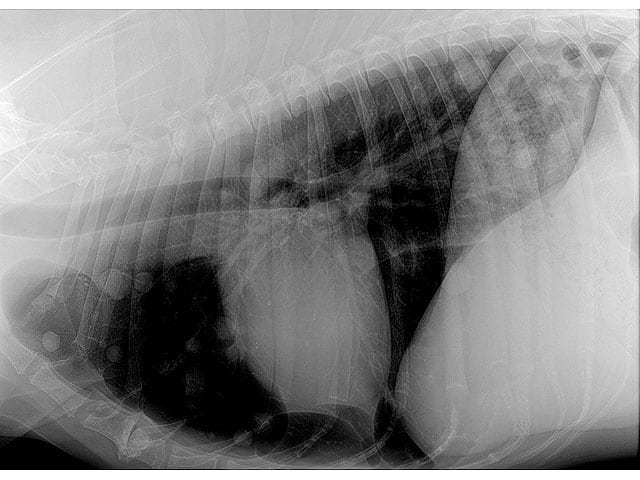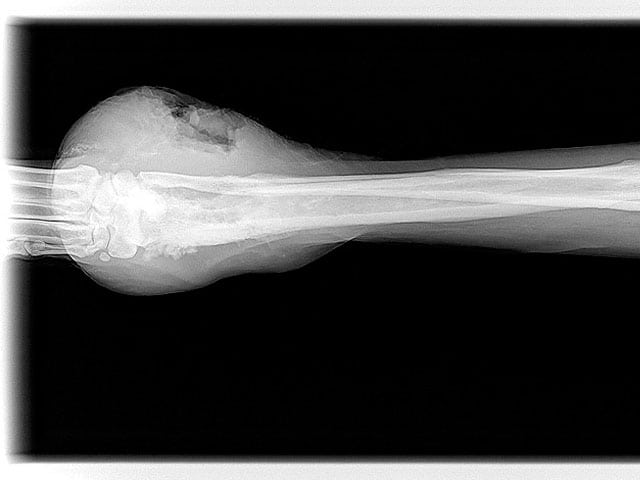Tripawds Three Legged Dog & Cat Forum Archives
Tripawds is your home to learn how to care for a three legged dog or cat. Explore 17+ years of forum archives for stories and answers to questions about dog leg amputation, and cat amputation recovery. Enjoy fresh discussion and connect with members in the new Tripawds Support Circle.
Join The Tripawds Community
Register your free account to join the Tripawds Support Circle. Connecting with members and getting the support you need is now easier than ever with the Circle app!
✅ Easy Photo Upload
✅ Direct Messaging
✅ Subscribe to Topics.
✅ Live Chat and much more!
Forums Locked: Search archives for answers & join Tripawds Support Circle to keep discussion going!
FOR BEST RESULTS: USE ADVANCED SEARCH
10:48 am
Team Tripawds
Administrators
25 September 2009
 Offline
OfflineTo dog pawrents, there are few words scarier than “cancer” and “oncology.”
 Seventeen months after my amputation, I got lung mets. The news was bad, but we regained hope when we discovered the Veterinary Cancer Care center in Santa Fe, New Mexico. Once we stepped into the VCC's warm, friendly clinic and found out how they could help me, our fears disappeared. After all, how could cancer be so scary when I had a crew of friendly experts doting over me?
Seventeen months after my amputation, I got lung mets. The news was bad, but we regained hope when we discovered the Veterinary Cancer Care center in Santa Fe, New Mexico. Once we stepped into the VCC's warm, friendly clinic and found out how they could help me, our fears disappeared. After all, how could cancer be so scary when I had a crew of friendly experts doting over me?
The Southwest's Best Specialty Care
Since 2004, the Veterinary Cancer Care clinic has provided the most compassionate, modern cancer care in the Southwest. Founded by Dr. Jeanette Kelly, a board-certified oncologist and graduate of Colorado State University's vet school, the VCC team helped me successfully battle cancer while making my quality of life the number one priority. Thanks to their advanced treatment with Metronomic Therapy and their K9 Immunity clinical trial I participated in, I fought cancer longer than anyone ever thought pawsible.
In April, my pawrents returned to the VCC to see what they've been up to since our last visit in 2008. The clinic has grown tremendously, especially after relocating to a campus which also houses the Veterinary Emergency and Specialty Centers of New Mexico (VESC), a 24-hour animal emergency and specialty center.
The VESC is a one-stop-medical center where animals can receive the most modern specialty care available for surgery, internal medicine, ophthalmology, dermatology, oncology, physical therapy, dentistry, animal behavior, and acupuncture.
X-Rays, CAT Scans and MRIs: What's the Difference?
 In this first video interview at VESC, Dr. Laura Hady, a veterinarian certified in canine physical therapy, explains the difference between digital radiographs, MRI and CT scans. The VESC has the only veterinary Magnetic Resonance Imaging (MRI) in New Mexico, and computed axial tomography (CT) scan equipment in their Albuquerque facility.
In this first video interview at VESC, Dr. Laura Hady, a veterinarian certified in canine physical therapy, explains the difference between digital radiographs, MRI and CT scans. The VESC has the only veterinary Magnetic Resonance Imaging (MRI) in New Mexico, and computed axial tomography (CT) scan equipment in their Albuquerque facility.
Dr. Hady will also discuss which technologies are best at diagnosing things like lung metastasis, cancerous growths and fractures. She also explains how fast osteosarcoma can grow in a dog's leg and lungs, as she shows us chest and leg X-rays of a bone cancer dog who wasn't a candidate for amputation.
If you're the patient of a dog cancer patient and wondering what technologies will provide the best look at your dog's cancer, remember these differences:
Computerized Tomography (aka "CAT Scan" or "CT Scan)
 While digital X-rays are better than film X-rays, Dr. Hady says that lesions less than 3 millimeters large won't always show up on any X-rays, and it may be hard to distinguish between a lung met and an alveoil. With X-rays, a tumor can only be seen from a few angles, but with a CT scan, the surgeon knows exactly where the tumor begins and ends.
While digital X-rays are better than film X-rays, Dr. Hady says that lesions less than 3 millimeters large won't always show up on any X-rays, and it may be hard to distinguish between a lung met and an alveoil. With X-rays, a tumor can only be seen from a few angles, but with a CT scan, the surgeon knows exactly where the tumor begins and ends.
A CT Scan uses X-ray images taken from many different angles around the animal, which are then processed as a computer to show cross-sectional slices of the body. Dr. Louise Murray, DVM, author of "Vet Confidential," says that CT scans are best at detecting small abnormalities, such as metastatic cancer in the lungs. CT Scans require general anesthesia and sometimes contrasting agents must be injected into the body to enhance the images.
Magnetic Resonance Imaging (aka "MRI")
 Unlike an X-ray or CT scan, MRIs do not use radiation to process images. Dr. Murray explains that MRIs use strong magnetic fields and pulsed radio frequency waves that cause hudrogen protons in the body to wobble, and then relax. As this happens, the proton s emit signals, which are then processed by a computer to form images."
Unlike an X-ray or CT scan, MRIs do not use radiation to process images. Dr. Murray explains that MRIs use strong magnetic fields and pulsed radio frequency waves that cause hudrogen protons in the body to wobble, and then relax. As this happens, the proton s emit signals, which are then processed by a computer to form images."
MRIs give exceptional detail of soft tissues, such as the shoulder, brain and spinal cord. MRIs can be used to diagnose tumors, strokes and herniated spinal disks as well as neurological issues. MRIs require general anesthesia.
Stay tuned for more great canine cancer information and tips we learned from the good people at the VESC and the Santa Fe Veterinary Cancer Care center.
Many thanks to the good people at the Veterinary Cancer Care and Veterinary Emergency Specialty Center for spending the day with us! Catch our other VCC / VESC interviews:
- VCC / VESC Interview #2: Tripawd Max Does Swimmingly Well, Even After Hip Replacements
- VCC / VESC Interview #3: Bisphosphonates: When Amputation isn’t an Option
- VCC / VESC Interview #4: How to Pick a Veterinarian for Amputation Surgery
“Veterinary Cancer Care P.C. is committed to providing compassionate, high quality treatment to all pets with cancer. Using state of the art therapies, nutrition and kind care, we treat the whole patient, not just the cancer. To alleviate the hardships of cancer, our staff provides a positive family atmosphere, filled with love and hope. We hold a great respect for the human-animal bond, and will always honor your relationship with your pet above all."
"Veterinary Emergency & Specialty Centers of Santa Fe is a state-of-the-art veterinary hospital that provides emergency care for injured and sick dogs and cats as well as specialty medical and surgical treatment by skilled doctors on a referral basis. "
Tripawds Founders Jim and Rene
tripawds.com | tripawds.org | bemoredog.net | triday.pet
12:03 pm
14 August 2009
 Offline
OfflineVery interesting discussion! Thanks for posting it!
I just wished it wasn't so darned expensive to get a CT or MRI! Maybe it's just the place I went but my CT estimate with all of the stuff you have to do with putting the dog under: $4059 (with $352 of that being radiographs).
For those of my friends that didn't think I had a spending limit on Comet - I DID! 
 Comet - 1999 to 2011
Comet - 1999 to 2011
She departed us unexpectedly January 23, 2011 at the age of 12 1/2.
She was born with a deformed front leg and a tripawd all of her life.
9:38 pm
Team Tripawds
Administrators
25 September 2009
 Offline
OfflineGlad you liked it.
Ouch. I know that at Davis when Jerry got DXd a MRI was somewhere around $3500. He had a CT scan instead, and I can't recall the price. I think I'm blocking.
Just another reason why Pet Insurance is beginning to be the norm these days.
Tripawds Founders Jim and Rene
tripawds.com | tripawds.org | bemoredog.net | triday.pet
1 Guest(s)


 Log In
Log In Members
Members

 Read the original blog post
Read the original blog post







